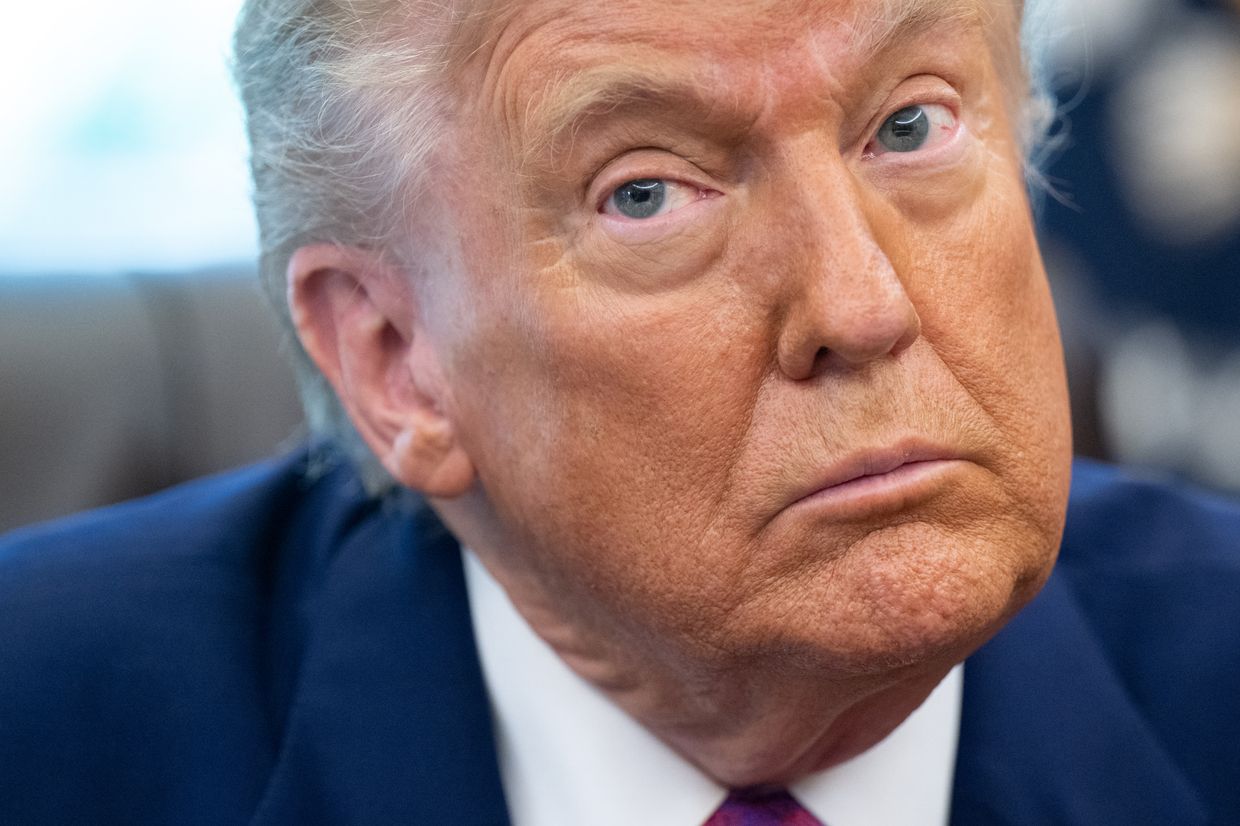A “two week” deadline imposed by U.S. President Donald Trump to see if Russia is serious about peace in Ukraine has come and gone, with Moscow’s escalation of attacks on civilians during this period failing to draw the slightest condemnation from the White House.
"We’re going to find out very soon. It’ll take about two weeks, or a week and a half,” Trump told reporters on May 28, responding to a question on whether Russian President Vladimir Putin wants to end the war.
His comments came two days after Russia carried out the biggest drone attack of the full-scale war, which reportedly involved 355 Shahed-type attack drones and decoys.
Since the deadline was imposed, this record has been broken twice — Russia attacked Ukraine overnight on June 1 with 472 Shahed-type attack drones, and on June 9, 479 drones and 20 missiles were launched against Ukrainian cities.
The figures are stark. In March 2025, Russia launched 4,198 drones at Ukraine, which is so far the largest monthly number of drones launched during the full-scale invasion.
But if the intensity of attacks so far in June continues, that figure could reach nearly 7,000.
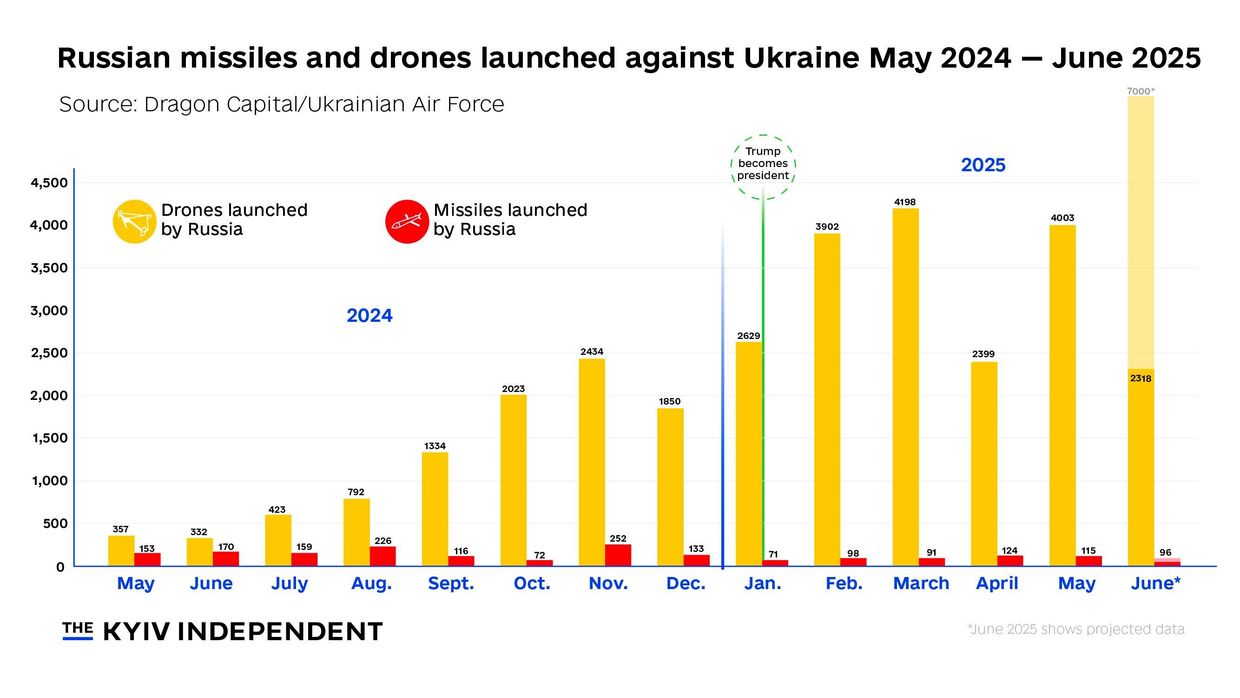 Russian missiles and drones launched against Ukraine May 2024-June 2025. (Nizar al-Rifai/The Kyiv Independent)
Russian missiles and drones launched against Ukraine May 2024-June 2025. (Nizar al-Rifai/The Kyiv Independent)
“This is terrorism against the civilian population aimed to create a sense of doom, war-weariness, and to put pressure on the (Ukrainian) authorities,” Rodion Rozhkovskiy, co-founder of Liveuamap, told the Kyiv Independent.
Despite previously hinting at the imposition of new sanctions against Russia if the Kremlin doesn’t show a desire to end the war, Trump has so far taken no action against the ongoing escalation of violence by Moscow’s forces.
“Lately, every attack instills a huge fear that does not disappear until the air alarm is over.”
Instead, Trump on June 6 excused Russia’s escalating attacks, saying Ukraine’s Operation Spiderweb, an attack on Russian bomber aircraft, “gave Putin a reason to go in and bomb the hell out of them.”
Operation Spiderweb was a clinical strike against legitimate military targets. Russia’s drone strikes indiscriminately target civilians, illegal under international law.
On June 12, for the first time since the launch of the full-scale invasion, U.S. Secretary of State Marco Rubio released a statement to mark Russia Day.
“On behalf of the American people, I want to congratulate the Russian people on Russia Day,” Rubio said.
“The United States remains committed to supporting the Russian people as they continue to build on their aspirations for a brighter future.”
Meanwhile in Ukraine, a brighter future for those living in cities under near-nightly bombardment by the Russian people seems far out of reach.
“Lately, every attack instills a huge fear that does not disappear until the air alarm is over,” Kyiv resident Oleksandra Pshenychna, 20, told the Kyiv Independent.
“The worst feeling that comes is despair accompanied by a sense of emptiness, inevitability, and hatred for those people who are behind the launch of Russian drones and missiles into residential buildings, cultural monuments, and crowds of people,” she added.
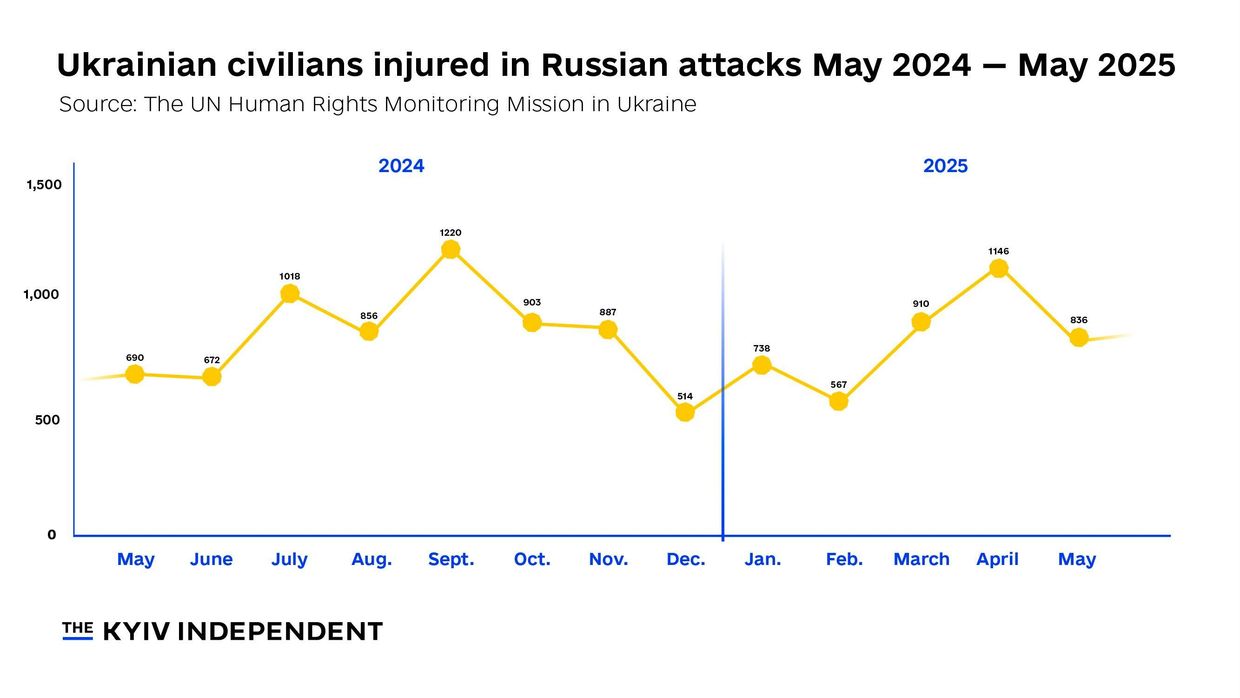 Ukrainian civilians injured in Russian attacks May 2024-May 2025. (Nizar al-Rifai/The Kyiv Independent)
Ukrainian civilians injured in Russian attacks May 2024-May 2025. (Nizar al-Rifai/The Kyiv Independent)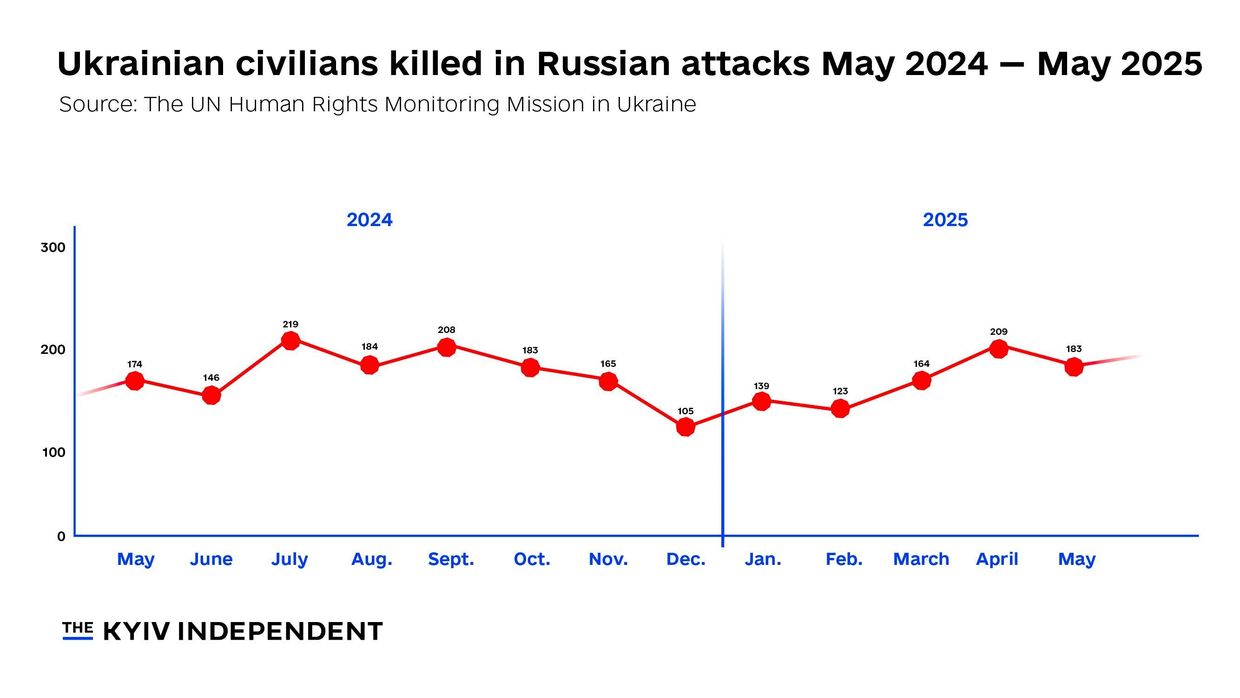 Ukrainian civilians killed in Russian attacks May 2024-May 2025. (Nizar al-Rifai/The Kyiv Independent)
Ukrainian civilians killed in Russian attacks May 2024-May 2025. (Nizar al-Rifai/The Kyiv Independent)
Russia’s disregard for Trump’s statements and threats long predates his two week deadline — data on Russian drone strikes clearly indicate that despite the U.S.-led peace process initiated after Trump took office, Moscow has launched larger drone attacks on civilians than it did during the presidency of Joe Biden.
This is despite Trump’s multiple promises to end the war in 24 hours, which then turned into 100 days. Trump has now been in office for 144 days.
His search for a peace deal has seen a flurry of diplomatic meetings around the globe, severe and sustained pressure on Ukraine, and a reluctance to force any concessions from Russia.
During this time, Russia has continued to attack Ukraine on a daily basis. Ahead of the second round of direct peace talks held in Istanbul on June 2, Russia killed 9 civilians and injured 49 others.
“They [russians] are using all they can use — if they could use more, they would use more.”
Kharkiv resident Mykola Zhydkov told the Kyiv Independent that he has noticed that particularly heavy bombardments often actually coincide with peace process-related events that the White House portrays as positive steps towards a potential ceasefire.
“On June 10, POWs were swapped. On the same night, Kharkiv suffered a major attack,” Zhydkov said.
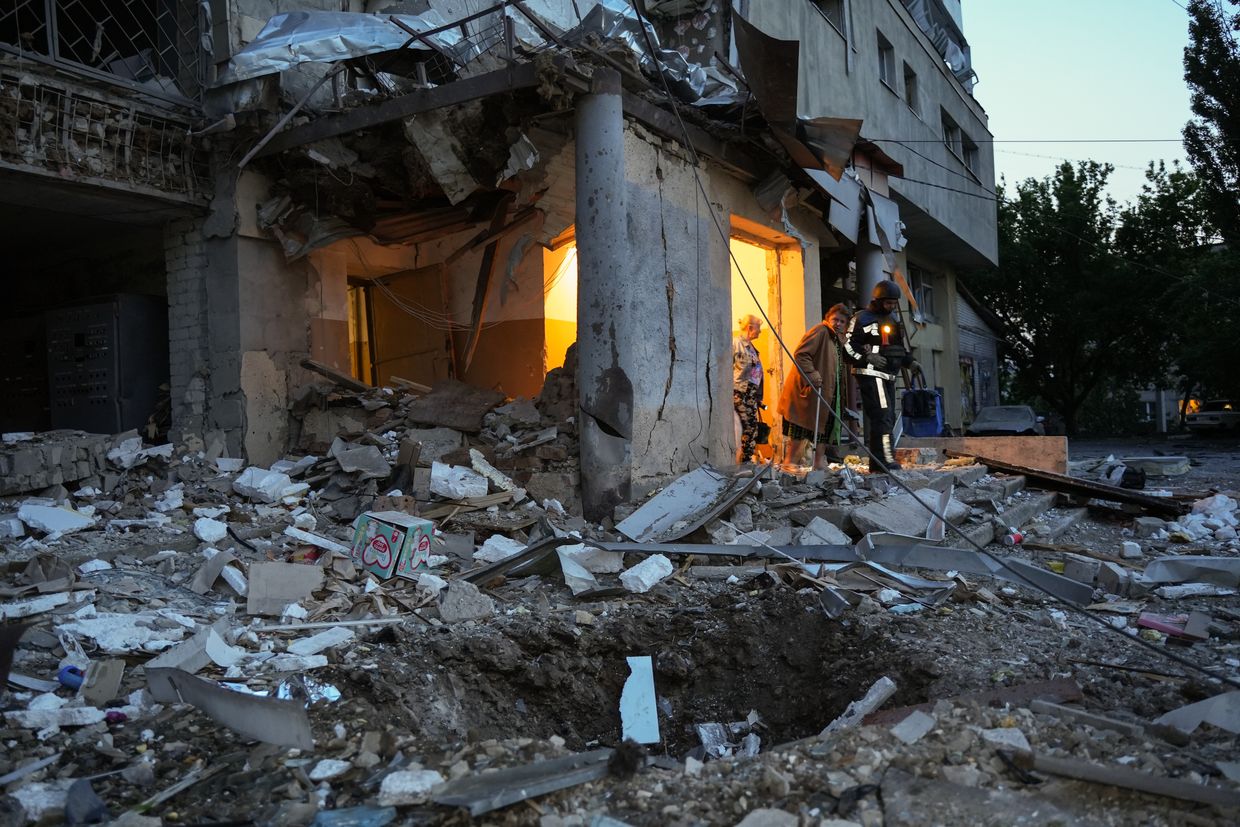 An elderly woman walks with the help of a rescuer amid rubble from a damaged residential building after a Russian drone attack in Kharkiv, Ukraine, on June 12, 2025. (Viacheslav Mavrychev / Suspilne Ukraine / Global Images Ukraine via Getty Images)
An elderly woman walks with the help of a rescuer amid rubble from a damaged residential building after a Russian drone attack in Kharkiv, Ukraine, on June 12, 2025. (Viacheslav Mavrychev / Suspilne Ukraine / Global Images Ukraine via Getty Images)
With Trump so far failing to respond to Russia’s escalating drone strikes, the Kremlin has little incentive to stop. All signs point to Moscow’s defense industry only increasing its ability to launch ever-larger mass attacks.
According to Rozhkovskiy, the only limiting factor in how many drones Russian can launch in any given attack is how many its factories can produce.
“They are using all they can use — if they could use more, they would use more,” he said.
The Russian production surge is being facilitated by imports of components from China and the recruitment of low-skilled labor from foreign countries, including from those in Africa.
Russia is also building new launch sites and will soon be able to deploy more than 500 long-range drones a night to attack Ukraine, a source in Ukraine’s military intelligence (HUR) told the Kyiv Independent last week.
Read also: Israel-Iran war could provide economic boost Russia needs to continue fight against Ukraine
From The Kyiv Independent - News from Ukraine, Eastern Europe via this RSS feed


